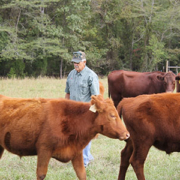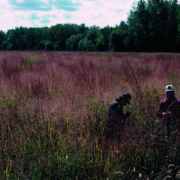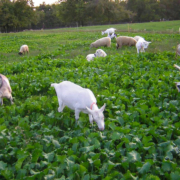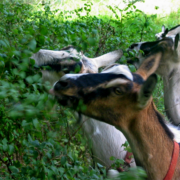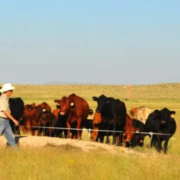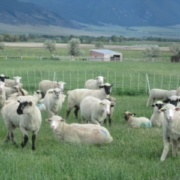Paddock Design and Animal Movement
By Lee Rinehart, NCAT Agriculture Specialist, and Justin Morris, NCAT Regenerative Grazing Specialist
Thinking of setting up a multi-paddock grazing system? Or maybe redoing an existing series of paddocks? Perhaps you’re interested exploring the most efficient ways to move livestock through multiple paddocks on a daily basis. The best place to begin is to start with what you have. If you are just starting out with a large, open pasture where livestock spend several weeks or longer, consider using electric fencing to section off a small piece that would provide sufficient forage for a few days and turn the animals in. Watch them and notice their grazing behavior. Do they scatter about the paddock or stay in a bunch? Do they graze awhile and then scatter out and lay down? Notice the condition of the forage after they have been grazing. Is it grazed hard or close to the ground? Are there tufts of bunchgrasses and forbs that weren’t grazed? Is some of the forage matted and trampled down? All these are clues as to how well you sized the paddock, and how well you timed their grazing period.
Observe and adjust. The next paddock may be bigger or smaller, depending on what you observed. Generally, paddocks should be small enough to promote uniform grazing. You can section off a portion of the pasture with polywire, step-in posts, and a portable fence charger. Importantly, you can adjust the paddock size as the season progresses and forage growth slows down. If you must keep animals on a paddock for more than a few days to graze to a set stubble height, this probably indicates a field or paddock that is too large for the number of livestock present. This can occur early in the season. If livestock cannot keep up with forage growth during the early season, there are at least two options to consider. The first is to reduce the size of the paddocks and cut some of the forage as hay. The livestock can be turned onto the mowed fields later after appropriate recovery of the pasture.
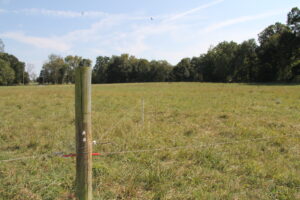
Photo: NCAT
A second option during fast forage growth is to make paddocks larger so that livestock graze over the fields very quickly—a strategy known as flash grazing. This falls in line with the adage, “When forage grows fast, move (or rotate) livestock fast, and when forage grows slow, move slow.” The principle is that livestock should be moving through the rotation at the rate forage is regrowing. You must monitor the rate of plant growth and then exert control through modification of paddock size and graze period to ensure livestock move through fields at the rate plants are regrowing to prevent overgrazing.
How about paddock shape? Long, narrow paddocks are extremely versatile. If the species and class of livestock are finishing cattle for which high rates of gain are a priority, narrow paddocks are great because you can advance the whole length of polywire ahead at the same time so that livestock simply walk forward a few feet to access fresh forage in the next paddock. Then, after three to five days, a back fence of polywire could be installed to prevent livestock from grazing the preceding paddock so that they don’t consume new growth.
When trampling forage is the priority, it’s best to use livestock that have lower nutritional needs than finishing livestock. A strategy to promote trampling is to create a 10- to 20-foot-wide opening at the far end of the next paddock, preferably where the fence reel is located. Instead of livestock being allowed to walk forward a few steps to access fresh forage, livestock in this scenario can only access the next paddock by walking to the far end. This strategy encourages a lot of trampling because all the livestock enter the paddock through one small opening. As livestock enter the new paddock, when one animal stops to graze, the animal behind it walks past the one grazing before it stops to graze. This pattern of one animal passing another continues until they reach the far end of the paddock.
Moving animals from one paddock to the next in rotation yields many benefits, not the least of which is providing fresh, nutritious forage. Frequent livestock movement also provides an opportunity to observe your livestock and allows you to gain an understanding of herd health and nutrition. Observing animals daily as you move them lets you assess each animal’s status as it walks and interacts with other animals. Here, you can monitor for disease, injury, nutritional status, calving/lambing/kidding, and anything else that is important for herd health and productivity. In addition, you can assess the condition of forage in the new paddock and determine how long the animals should graze before being moved to the next paddock. Also, gaze back at the paddock most recently grazed to assess the impact the livestock had on the forage stand. Then, evaluate other paddocks grazed earlier to assess plant recovery. You can calibrate your system by making these observations and adjusting the amount of time animals remain on subsequent paddocks.
Livestock that have become accustomed to frequent moves anticipate new forage, and this makes the movement of animals from one paddock to the next much easier. For instance, cattle will approach when you enter the field to open a gap in a fence or move polywire. Simply open a wide gap and let the animals through into the next paddock. You can count animals and observe their status as they pass you. Then, it’s just a matter of making sure the waterer is accessible, closing the fence gap, and building the next paddock so it’s ready to go when you come back out again. Now you’re ready to walk the paddocks to assess the impact and make adjustments in your mind for upcoming rotations. Not a bad way to spend the morning!
You have a lot to think about when setting up paddocks and planning animal movements. The ATTRA publication Paddock Design, Fencing, Water Systems, and Livestock Movement Strategies for Multi-Paddock Grazing goes into detail about designing a grazing system, including fencing, tools, watering systems, stream crossings, and offers recommendations on livestock movement strategies based on various grazing scenarios.https://attra.ncat.org/publication/paddock-design-fencing-water-systems-and-livestock-movement-strategies-for-multi-paddock-grazing/
Related ATTRA Resources
Adaptive Grazing – You Can Do It
Other Resources
Electric Fencing for Serious Graziers
Watering Systems for Serious Graziers
This blog is produced by the National Center for Appropriate Technology through the ATTRA Sustainable Agriculture program, under a cooperative agreement with USDA Rural Development. ATTRA.NCAT.ORG.

